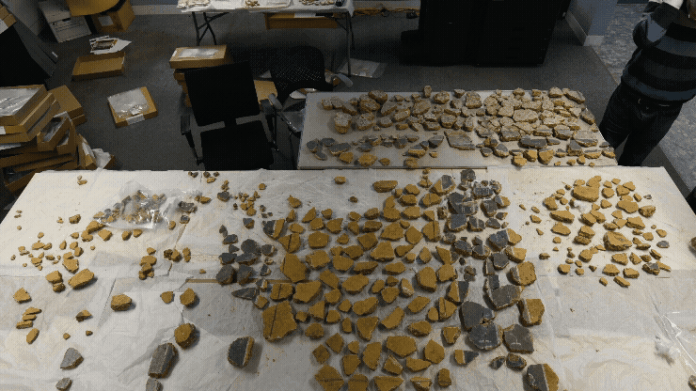One of the remarkable things about a city like London, which has been inhabited for nearly 2,000 years, is that no matter where a developer chooses to build, chances are there’s some relic of the past buried below ground. Archaeologists are routinely called to new development sites to carefully verify the presence—or not—of everything from early structures to centuries-old graveyards. And in a place founded by the Romans shortly after 43 C.E., we can occasionally glimpse astonishing finds from well over 1,000 years ago.
This year, a team of researchers from the Museum of London Archaeology (MOLA) has been hard at work in a development site known as The Liberty, which has already revealed ancient mosaics and a mausoleum. But the discoveries keep coming. Scattered in pieces, the city’s largest-ever collection of painted Roman plaster was found amid the rubble, dating back at least 1,800 years.

The first structures on this site appeared between 43 and 150 C.E., and the frescoed wall would have stood in a high-status Roman building. Sometime before 200 C.E., the building was demolished and the plaster pieces discarded in a pit. Seeing the light of day for the first time since, it was a dream opportunity for MOLA researchers.
Han Li, MOLA’s Senior Building Material Specialist, spent three months reconfiguring the artwork with the help of a team of researchers. He explained that pieces had been jumbled together when the building was demolished, so figuring out how the fresco was originally composed took a lot of tinkering and patience. “It was like assembling the world’s most difficult jigsaw puzzle,” he says.
Even the most avid jigsaw fans will appreciate that this type of puzzle is a real mind-bender—there’s no picture to look at for comparison. But there are clues. This era of Roman painting commonly incorporated color panels with border motifs and elements that imitated stone slabs like porphyry without the expense or labor involved in hauling that much material. And while this work is fairly representative of the style, the use of the color yellow is particularly rare and found in only a few very luxurious buildings around the U.K.
The fresco also tells the story of visitors and passersby who left graffiti, including an image of a crying woman with a hairstyle common in the Flavian period (69 to 96 C.E.) and a carved Greek alphabet. It’s thought that the latter could have served a practical purpose, like a tally sheet or a checklist.

One special detail comes in the form of what’s known as a tabula ansata, a carving of a decorative tablet that Roman artists used to sign their work. It contains the Latin word “FECIT,” which means “has made this.” Sadly, the part where the artist’s name would have appeared is too broken to determine, so their identity will likely remain a mystery.
Explore more of MOLA’s excavations and projects on its website.












